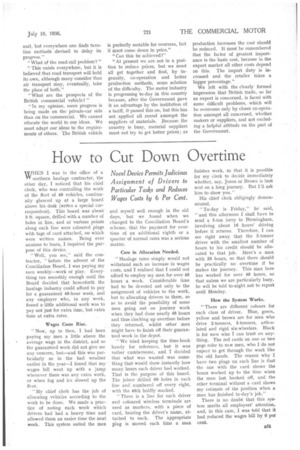How to Cut Down Overtime
Page 41

If you've noticed an error in this article please click here to report it so we can fix it.
Novel Device Permits Judicious Assignment of Drivers to Particular Tasks and Reduces Wages Costs by 6 Per Cent.
WHEN I was in the office of a VY northern haulage contractor, the other day, I noticed that his chief clerk, who was controlling the work of the fleet of 40 vehicles, continually glanced up at a large board above his desk (writes a special correspondent). This board was about 3 ft. square, drilled with a number of holes in line, and at various points along each line were coloured plugs with tags of card attached, on which were written names. Being ever anxious to learn, I inquired the purpose of this device.
" Well, you se," said the contractor, "before the advent of the Conciliation Board, I was paying my men weekly—work or play. Everything ran smoothly enough until the Board decided that henceforth the haulage industry could afford to pay for a guaranteed 48-hour week, and any employer who, in any week, found wade additional work was to pay not just for extra time, but extra time at extra rates.
Wages Costs Rise:
" Now, up. to then, I had been paying my men a little above the average wage in the district, and so the guaranteed week did not give me any concern, but—and this was particularly so in the bad weather earlier in the year—I found that my wages bill went up with a jump whenever there was any extra work, or when fog and ice slowed up the fleet.
" My chief clerk has the job of allocating vehicles according to the work to be done. We made a practice of noting each week which drivers had had a heavy time and allowed them an easier time the next week. This system suited the men and myself well enough in the old days, but we found when we changed to the Conciliation Board's scheme, thit the payment for overtime of an additional eighth or a quarter of normal rates was a serious matter.
Care in Allocation Needed.
" Haulage rates simply would not withstand such an increase in wages costs, and I realized that I could not afford -to employ my men for over 48 hours a week. Considerable time had to be devoted not only to the assignment of vehicles to the work, but to allocating drivers to them, so as to avoid the possibility of some men going out on journey work when they had done nearly 48 hours and thus clocking up overtime before they returned, whilst other men might have to finish off their guaranteed week in the depot.
"We tried keeping the time-book handy for reference, but it wasrather cumbersome, and I decided that what was wanted was something that would show instantly how many hours each driver had worked. That is the purpose of this board. The joiner drilled 60 holes in each line and numbered off every eight, with the 48th boldly marked.
" There is a line for each driver and coloured wireless terminals are used as markers, with a piece of card, bearing the driver's name, attached to each. The appropriate plug is moved each time a man finishes work, so that it is possible for my clerk to decide immediately whether, say, Jones or Brown is best sent on a long journey. But I'll ask him to show you."
His chief clerk obligingly demonstrated.
"To-day is Friday," he. said, "and this afternoon I shall have to send a 5-ton lorry to Birmingham, involving about 16 hours' driving before it returns. Therefore, I can. see right away that the 5-tonner driver with the smallest number of hours to his credit should be allocated to that job. Here's a man. with 33 hours, so that there should be practically no overtime if be makes the journey. This man here has worked for over 40 hours, so that unless we are particularly busy, he will be told to-night not to report until Monday.
How the System Works.
"There are different colours for each class of driver. Blue, green, yellow and brown are for men who drive 2-tonners, 5-tonners, articulated and rigid six-wheelers. Black is for men who I can trust on anything. The red cards on one or two pegs refer to new men, who I do not expect to get through the work like the old hands. The reason why I have two plugs on each line is that the one with the card shows the hours worked up to the time when the man last booked off, and the other terminal without a card shows my estimate of the position when a man has finished to-day's-job."
There is no doubt that this system merits all employers' attention, and, in this case, I was told that it had reduced the wages bill by 6 per cent.
















































































